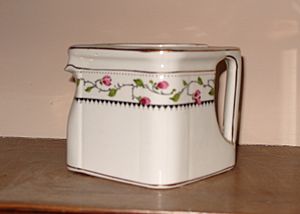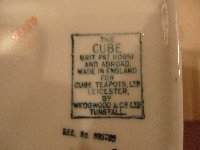Cube teapot facts for kids
The cube teapot is a special kind of teapot shaped like a cube! It was designed to be used on ships. Imagine a ship rocking on the waves – a regular round teapot might tip over and spill hot tea. But the cube teapot's flat sides helped it stay steady, preventing spills and keeping people safe.
Who Invented the Cube Teapot?
An Englishman named Robert Crawford Johnson (1882–1937) invented the cube teapot. He was a designer who started a company called "Cube Teapots Ltd" in 1917.
Johnson worked hard to make the perfect design. His cube teapot didn't drip, poured easily, and was strong enough to resist chips. Plus, its cube shape meant many teapots could be stacked neatly for storage. It looked exactly like its name – a simple cube, with no spout or handle sticking out.
The first cube teapots were made in 1920 by Arthur Wood of Stoke-on-Trent, England, using earthenware. Other companies later got permission to make them, including Wedgwood & Co Ltd. Even silversmiths Napper and Davenport of Birmingham made a silver version, which you can see at the Victoria & Albert Museum! T G Green Cornishware also produced these unique teapots.
Where Were Cube Teapots Used?
Cube teapots were very popular on ships because they were so stable. The Cunard shipping company used them on famous ocean liners like the Queen Elizabeth 2 until the 1980s, and also on the Queen Mary.
They were also commonly found in tea shops. Their strong, robust design meant they could handle a lot of use without breaking easily, which was perfect for busy places.
Exhibitions and Books
In 2000, there was a special traveling exhibition about cube teapots. It was sponsored by Twinings and shown at places like the Merseyside Maritime Museum in Liverpool and Leicester's New Walk Museum. A book called The Cube Teapot was also written by Anne Anderson in 1999, sharing more about their history.



